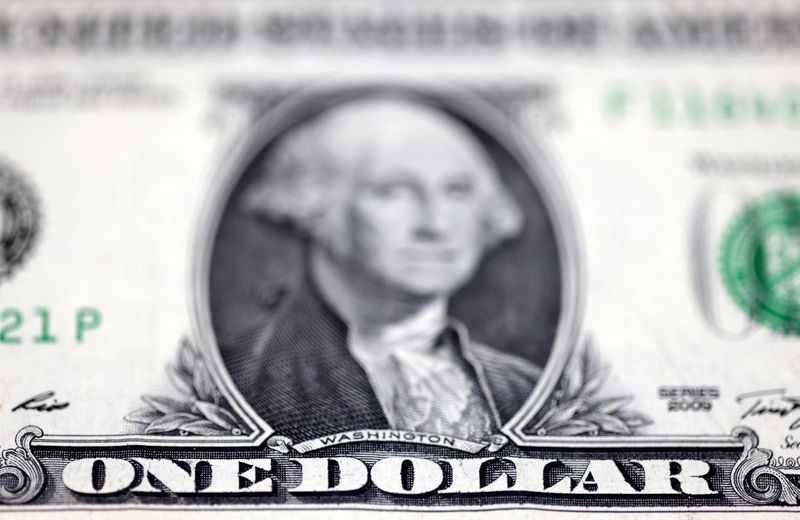 © Reuters. FILE PHOTO: U.S. Dollar banknote is seen in this illustration taken July 17, 2022. REUTERS/Dado Ruvic/Illustration/File Photo
© Reuters. FILE PHOTO: U.S. Dollar banknote is seen in this illustration taken July 17, 2022. REUTERS/Dado Ruvic/Illustration/File Photo
By Gertrude Chavez-Dreyfuss
NEW YORK (Reuters) -The dollar rose to a more than one-week high on Friday after a mixed batch of data showed the U.S. economy remained stable with small pockets of weakness, suggesting the Federal Reserve could keep interest rates higher for longer or reduce the planned number of rate cuts this year.
The dollar index, which tracks the U.S. currency against six major peers, was on pace to post a weekly gain of 0.7%, the largest since mid-January. The index was last flat at 103.43.
Data on Friday showed a solid U.S. manufacturing sector, with output rebounding by 0.8% last month after a downwardly revised 1.1% decline in the prior month. Analysts at Citi, however, said in a research note that the rebound in February partly reflects the revisions lower to January output and the reversal of a "weather-related drag in January in non-durable goods manufacturing sectors."
U.S. consumer sentiment and inflation expectations were little changed in March, a survey showed on Friday. The University of Michigan's preliminary reading on the overall index of consumer sentiment came in at 76.5 this month, compared to a final reading of 76.9 in February.
The survey's reading of one-year inflation expectations, a measure tracked by the Fed, was unchanged at 3.0% in March. The survey's five-year inflation outlook held steady as well at 2.9% for the fourth straight month.
The Fed is scheduled to meet next week and while it is not expected to make any interest rate moves, hotter-than-expected U.S. producer and consumer price data this week has led traders to rein in bets on future cuts.
"Ahead of the meeting, there's nothing to indicate that the Fed can afford to be dovish at this point," said Eugene Epstein, head of structuring for North America at Moneycorp in New Jersey.
"That's why we have Treasury yields going up and that's why we have the dollar stronger. Gold fell as well. It's all the standard correlations. So the Fed maybe gets higher for longer: they're not being given any room to cut sooner than later."
The rate futures market on Friday has priced in a 57% chance of the Fed cutting rates in June, compared to 71% on Monday, according to LSEG's rate probability app. The market has also reduced the number of rate cuts it expects this year to less than three, from between three and four earlier this year.
Investors are also looking to a highly-anticipated meeting at the Bank of Japan next week.
The BOJ is close to ending eight years of negative interest rate policy, with internal preparations for an exit in the works since Kazuo Ueda took office as BOJ governor.
At the same time, Japan's biggest companies agreed with labor unions to raise wages by the highest level in 33 years on Friday, reinforcing views the country's central bank is poised to make a landmark shift away from negative interest rates.
The dollar continued to rise against the yen, up 0.5% at 149.02. On the week, the greenback rose 1.3%, on track for its biggest gain since mid-January.
The focus is also on other central bank decisions for signs of how quickly they will cut interest rates after a period of rapid rises to curb rampant inflation. The Bank of England and Swiss National Bank are due to meet next week.
The euro was slightly up at $1.0889. The European Central Bank council last week began a discussion on when to reduce its own rates, council member Olli Rehn said on Friday.
Sterling slipped 0.1% to $1.2737.
In cryptocurrencies, bitcoin prices fell as much as 7% in volatile trade from a record high touched on Thursday as risk sentiment took a hit. It was last down 0.3% at $70,483.

